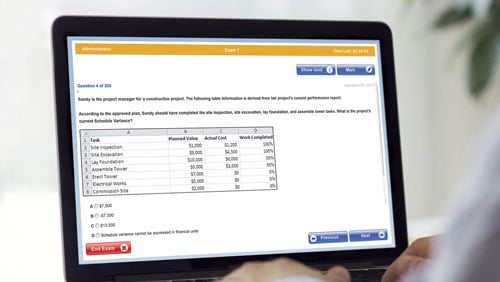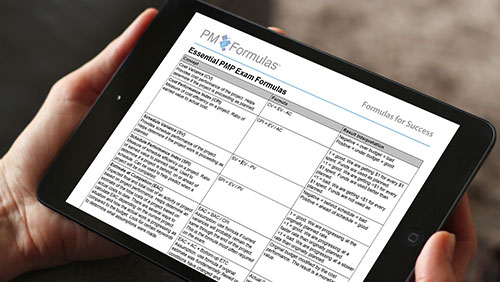Meeting Management Techniques for the PMP® Exam
 Have you ever been in a meeting and then sent a text message from your phone that read: Help! I'm Stuck in this Meeting and They Ran out of Donuts? I hope that you never have to and I also hope that anyone attending YOUR meetings never feels that such a cynical text message is necessary when you are leading it. But what exactly makes a good meeting? What are the meeting management techniques that project managers have to know and master?
Have you ever been in a meeting and then sent a text message from your phone that read: Help! I'm Stuck in this Meeting and They Ran out of Donuts? I hope that you never have to and I also hope that anyone attending YOUR meetings never feels that such a cynical text message is necessary when you are leading it. But what exactly makes a good meeting? What are the meeting management techniques that project managers have to know and master?In this article, I will cover what you need to know about this subject for the PMP® Exam, and you’ll also pick up some great tips for managing successful meetings every time. I’ll share exactly what you have to do to manage your meetings successfully including the 10 essential meeting management techniques that you won’t want to miss!
PMP Meeting Management Techniques Defined
Let’s begin by defining what meeting management techniques are. They are the activities you do in the meeting to manage the discussion and to get a clear outcome. If you think that sounds similar to ‘meeting best practices’ then you’d be right! Meeting management techniques can also include the tasks you do either side of the meeting such as issuing the project management meeting agenda in advance and following up actions afterwards.
Meeting management techniques are an important part of how project managers do their job, and if you think the skills are all common knowledge then you’d be mistaken. I’m sure you can think of meetings that you have attended where there has been no agenda and you’ve left the room knowing that the actions won’t be documented. As a PMP, meeting management skills help you avoid those situations.
10 Essential Meeting Management Techniques for PMP
Let’s dive straight into the details. Here are 10 essential meeting management techniques for PMP certifed professionals to master.
1. Develop a meeting objective
This is really important because you should be leaving the meeting knowing that something is different on your project, even if that is that you have just updated everyone.
2. Develop the agenda
This is something that a lot of project managers struggle with, so if it feels difficult to you, be assured that you are not alone! The tip I have here is to standardize your project management meeting agenda as much as possible. Then you’ll only have to change a few items every time you have the meeting.
Ask your team and the others who are attending the meeting to contribute their topic suggestions for the agenda in advance. This gives you early warning of the subjects that people want to discuss and helps the discussion stay on track.
3. Send the agenda ahead of time
Remember to issue your agenda generally a few days beforehand. Any earlier and the attendees will forget they’ve got it!
4. Tailor the meeting to your culture
Make sure that the meeting is suited to the environment you are in. An informal workshop isn’t going to be successful in a very formal office environment, for example.
5. Invite the right people
The right people for your meeting are determined by your meeting objectives. Think about who will help you achieve those objectives and work on getting everyone there. If the ‘right’ person is unavailable, ask them to delegate their attendance to someone else. The delegate should be able to cover the items on the agenda that relate to their area. Ask that the delegate is fully briefed and has responsibility to commit to decisions.
If, however, you think that it’s imperative that the “right” person and not a delegate participates then you will have to change the meeting date or time to make it possible for them to attend.
6. Start and end the meeting on time
This one is pretty straightforward! Just start at the time you think is right to start and let others join as they arrive. Next time hopefully they’ll get the message that you won’t hang around. It’s disrespectful of everyone’s time but remember that it means you can’t be late either.
7. Introduce everyone
As you open the meeting, spend a few moments going round the table asking everyone to introduce themselves. This is especially important when you are starting a project as the team might not know each other. This doesn't need to take long: name, department and role on the project are normally enough.
8. Manage conflict during the meeting
Conflict in a meeting is going to happen and it’s often about opposing viewpoints on a topic. Discussion is healthy, so let it happen and be aware of when it threatens to take over the meeting. At that point you should say that the topic needs to be taken offline. Record the fact that the discussion isn’t finished and be sure to pick it up again outside the current meeting otherwise you’ll find that it festers.
9. Assign someone to take notes
Unless it’s a meeting where there won’t be many actions or decisions, it’s important to make sure that there are notes covering what was talked about. It can be hard to chair a meeting and take adequate notes, so if necessary, get someone else to do the notes for you.
10. Document the action items with responsible parties
This normally takes the form of meeting minutes. Minutes should be written up and sent out within a few days of the meeting. If the meetings are long and detailed you will want to offer the team the opportunity to review them for errors before you issue a final version. Then you need to track that individuals with actions are working on their tasks and will be able to report back on progress during the next meeting.
Project Management Meetings With Virtual Teams
The 10 essential meeting management techniques above are perfect for in-person meetings and they also work well for virtual meetings. However, when your team isn’t physically with you for the meeting you should consider some other techniques for managing your meetings. Virtual meetings need additional preparation and management. For example, you should test your technology. Make sure that your webinar tool or screensharing app works and that you all know how to use it. Check the connections from wherever you are going to be joining from. Triple check the time zone conversions so that you are expecting everyone at the right time.
A final tip for virtual meetings is to try to create a level playing field. For example, don’t have the whole team in one place with a single individual joining by conference calls. That creates inequality in the experience of the meeting and is likely to lead to the person on the phone feeling as if they aren’t part of the discussion (or becoming so disengaged that they start focusing on other work instead of your meeting).
Taking it Further: More on Meeting Management for PMP
Meeting management techniques are something that you can learn and improve with time. The tips in this article will help you quickly boost your skills at managing meetings, but they are still only the start of your journey towards becoming a confident meeting chair.
And for the PMP Exam? When you are choosing a PMP training course, look at the syllabus and check that it covers meeting management along with everything else. You can be confident that The PM PrepCast includes everything you need to know about meeting management techniques for PMP, with comprehensive coverage of everything else you need to pass the PMP Exam.


